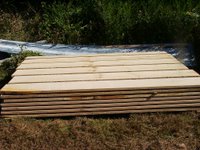Wild Cherry



Occasionally I'll come across large Wild Cherry logs. They usually come from land that is being cleared for housing development. Such is the case in the pictures above that were taken in 2003. In the left picture the log is on the mill and has been cut down to a square shape which is called a "cant". The boards in the center picture were sawed from the log to get down to the cant. These boards are awaiting to get the bark removed on each side. That removal is called "edging". This edging will be accomplished on the same milling machine after the cant is sawed and taken off the machine. The cant can be sawed in any desired thickness and all the boards from the cant will be the same width if the cant isn't turned during the sawing from top to bottom. The thickness scale I used here is called 4/4 (four quarters). You may ask if 4/4 is not the same as 1 inch. In saw milling a scale is used taking into account the thickness of the saw blade. This is referred to as "kerf". The kerf results in saw dust and the wider the kerf, the more waste from the log. Anyway, the scale is adjusted to consider the kerf and results in a boards that are 1" thick as they come from the log. When the boards dry, they will shrink to 7/8" or perhaps 15/16" depending on species and the precision of saw milling. There are other dimensions of thickness on this same scale, 5/4, 6/4, 8/4, 10/4, 12/4. Same theory, consider the kerf.
The picture on the right is the stacked lumber from this exceptional cherry log. It is stacked with one inch square "stickers" between each layer to enable drying slowly. This drying outdoors takes about a year to get the moisture content down to 10-12%.
Another day, I'll show resulting furniture that can be made from matrial like this cherry lumber.
Labels: Woodworking


0 Comments:
Post a Comment
<< Home